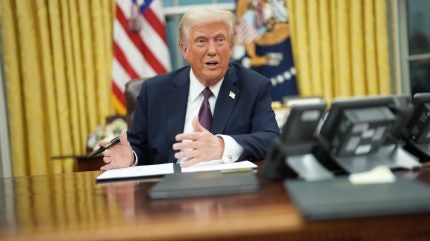
President Donald Trump said the promised 25% import tariffs on goods from Canada and Mexico, the US’ biggest trade partners, would arrive on 1 February. During his campaign, Trump promised he would apply universal tariffs ranging between 10% and 20%, and increasing to 60% for China.
“We are thinking in terms of 25% on Mexico and Canada because they are allowing vast numbers of people […] and fentanyl to come in,” he said. When asked by a reporter when he would enact those tariffs, Trump assured the reporter twice: “I think we will do it on 1 February.”
A week ago, he said on social media he would create the “external revenue service to collect our tariffs, duties, and all revenue that come from foreign sources”. He mentioned it in his inauguration speech at the Capitol.
There was much debate during the President’s campaign over whether he would actually apply tariffs or whether he would use them as a negotiating tactic to extract concessions from other countries.
Canada’s Minister of Foreign Affairs, Melanie Joly, was quick to respond and tried to assure Canadians their government was prepared.
“We have a plan. The plan is threefold. The first one is, we will continue to work on preventing tariffs and that is also why we have a very strong border plan. Second, we will work on preparing for a response […] We will be back with the Cabinet of course working on retaliation. And thirdly, we have to work on our long-term response,” she said in a press conference, along with the country’s Finance Minister Dominic LeBlanc.

US Tariffs are shifting - will you react or anticipate?
Don’t let policy changes catch you off guard. Stay proactive with real-time data and expert analysis.
By GlobalDataTrump did not sign an executive order on the matter. Many experts believed that, if the tariffs came, they would arrive towards the end of 2025 or early in 2026.
However, Trump’s team warned they would come in with an “awe and shock” approach that may involve making a show of strength regarding tariffs earlier on in his term.
High tariffs with their regional neighbours would particularly affect the US’ energy and auto industry and would undermine the US-Mexico-Canada Agreement, which replaced NAFTA during Trump’s first term.
Analysts from Bernstein Research told Bloomberg in November that Stellantis imports around 40% of cars it sells in the US from Canada and Mexico. General Motors imports around 30% and Ford around 25%.
Trump had initially said he would apply universal tariffs of 10–20% on all imported goods, and in China’s case up to 60%. While he said he was still considering a universal tariff, he said he was “not ready for that yet”.
China, on the other hand, seems to have dodged being part of at least the first part of Trump’s tariff plan, suggesting it might get time to negotiate a deal.
“We are going to have meetings and calls with President Xi,” Trump said. He said he had been invited to visit China but did not elaborate.
Following Canadian Foreign Minister Joly’s remarks, Finance Minister LeBlanc calmly said: “None of this should be surprising. The one thing we have learned is that President Trump at moments can be unpredictable.”




